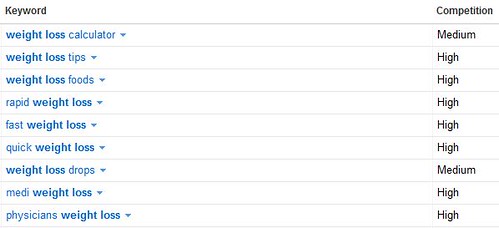This is a guest post! If you want to write for us, check out the Guest Post section.
After the hit of Google’s Panda and Penguin Updates, several high-ranking websites plummeted to the bottom of search engine result pages (SERPs).

[Image via Flickr]
You see, the impact of these algorithm changes can be very devastating because such sites have been using “spammy” optimization practices.
What does this information have to do with you then?
It means that you are in a good position, especially if you are just starting to work on your own website or still planning to develop one.
And, why is that?
You are at an advantage because you can jump-start your online platform using guaranteed methods.
So, which tactics are these?
With the main purpose of avoiding web spam (refers to webpages applied with techniques against Google guidelines), check out these vital SEO strategies.
1. Ensure fast loading time
Imagine yourself browsing the Internet for information. Then, you happen to see a link with a snippet that shows a promising description. You click on it and you are directed to a blank page that, unfortunately, takes some time to load. The question is, would you wait for it or look for other content? Most probably, you are going to do the latter.
Now, imagine your target audience going through the same situation on your site. The thought of users ditching your pages can be depressing, right? Hence, take note of these tips.
- Avoid using codes from CSS and JavaScript.
- Take advantage of image CSS sprites, so you can gather several photos in one file to minimise server requests and save bandwidth.
2. Place pictures
Hmm, that is a given. But, wait, there is more! You also have to consider the following:
- Flash is only attractive but it will not help you rank in Google search results. But if you wish to emphasise aesthetics on at least one page, you can add a navigation link and text to make it relevant. This is also applicable for simple images.
- Do not forget to incorporate related keywords.
3. Create content
By that, it does not necessarily mean articles. You can also post videos and pictures with captions. Or, you can combine all of these elements to come up with attention-grabbing and informative webpages. As you are doing so, remember these pointers.
- It should go well with your website’s theme or niche.
- Put relevant key phrases, so your content ranks in SERPs.
- Produce fresh content regularly to make the users want to visit your site frequently because you always have interesting stories or insights to share.
4. Use keywords
As you can see from the first three tips, the terms “keywords” and “key phrases” are always there. The biggest reason for this is that your Web content will rank well in SERPs if you include popular and high-ranking search terms. By that, it refers to phrases that many people use whenever they look for certain information.
Let us have a look at this image for a closer look at using the right keywords.

This is a list of keywords related to “weight loss” along with the competition rate and Global/Local search numbers. You can do such keyword research using Google Keyword Tool.
5. Add a sitemap
This is a page, which lists and links to major or all of the pages on your website. While you can choose not to create one, it helps spiders crawl your site easily; hence, increasing your chances of getting high ranking.
6. Connect through social media

[Image via Flickr]
Blogging is just one component. Apart from it, you can engage in social networking, photo sharing, and video uploading (among others).
But first, you need to sign up and create a profile page on top social sites such as Facebook, Twitter, Google+, and LinkedIn (a network for professionals). If you want to upload videos, you can log on to YouTube. On the other hand, you can upload and share images on Tumblr and Pinterest. Again, do not forget to include relevant keywords when filling out particular fields (e.g. bio, description, and interests) and posting status updates.
Joining these communities can offer several advantages. One, Google includes social profiles in its search results. Second, you can generate backlinks through your networking pages and blog articles. Third, you can enhance your credibility and authority online as your connection grows.
7. Place breadcrumb trails

They look like a tread of anchor texts to guide and show the users the pages they have viewed. You need to add these to aid with convenient navigation throughout your website as well as help easy search engine indexing.
8. Put meta tags
These special HTML tags allow you to provide details about a certain webpage. Most specifically, it lets you point out important elements such as titles, headers, and subheadings.
You need to create meta descriptions too. While doing so, you have to limit the characters to 155 or less, so the entire text will appear in search results. Finally, make them interesting and catchy to draw the attention of your target audience.
9. Create descriptive URLs
Check out these links and find out which one gives you a clear idea of what the webpage features.
- http://www.domainname.com/answer.ad?hejd=amkd=9934 (not a real URL)
- http://www.domainname.com/weight-loss-tips.html (also an example URL)
The first link seems vague, while the second tells you that it talks about dieting strategies. Now, that is what you call “descriptive” because it allows the users to determine the page’s content right away.
10. Assign anchor texts
These are clickable phrases, which direct your visitors to another webpage. In SEO sense, they help spiders search for relevant information. Therefore, you have to make sure that these texts connect well with the attached link because if they do not, it will keep you from ranking well.
There you have ten optimisation tips to jump-start an effective site. Now, these ideas may seem like a lot to handle at first. But as you go along the process of developing and designing your website, they will get easier and easier.
As a conclusion, you have to know that if these tasks turn out to be very overwhelming, you can always seek professional assistance. This way, you can guarantee that your domain and its content turn out well.
Author Bio
Emma Tomlinson is the Head of Retail at Smart Traffic, a UK-based specialist company offering SEO package services and solutions to both SMEs and large companies.
{ 1 comment… read it below or add one }
http://www.youtube.com/watch?v=RBTBEfd7z_Y
Meta Tags aren’t looked at by search engines buddy…